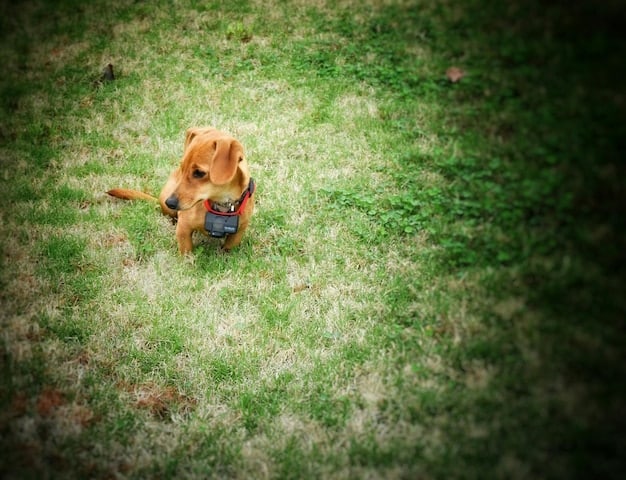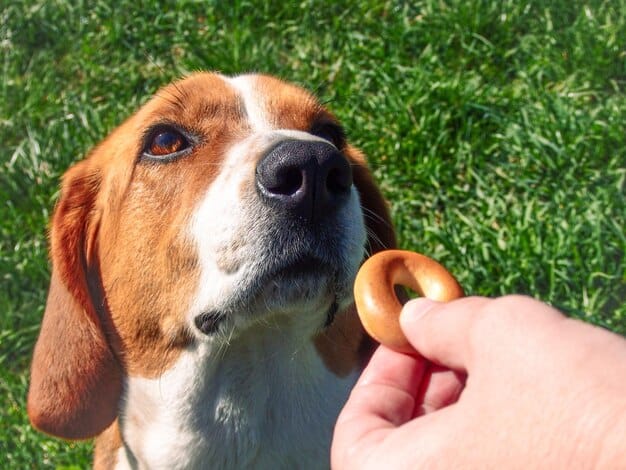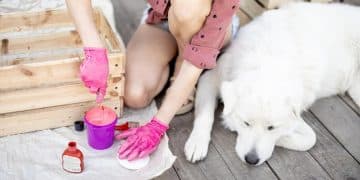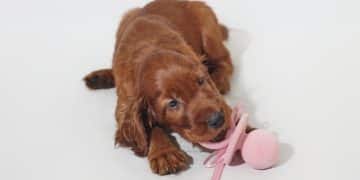Potty Training Your Puppy in 5 Days: US Insider Secrets

Potty training your puppy in 5 days is achievable for US dog owners by employing consistent routines, positive reinforcement, frequent potty breaks, crate training, and closely monitoring your puppy’s behavior to establish good habits quickly.
Bringing a new puppy into your home is an exciting experience, but it also comes with responsibilities. One of the first and most important tasks is potty training your puppy in 5 days. While it may seem ambitious, with the right approach and consistency, you can set your furry friend on the path to success, especially if you’re a dog owner in the US.
Understanding Puppy Potty Training Basics
Before diving into the 5-day plan, it’s essential to understand the fundamental principles of puppy potty training. This involves recognizing signs that your puppy needs to go, understanding their bladder control limitations, and creating a consistent routine to help them learn quickly.
Recognizing the Signs
Puppies exhibit various behaviors indicating they need to relieve themselves. Being attentive to these signs can prevent accidents and reinforce positive habits. By recognizing these cues, you can promptly take your puppy outside and reward them for eliminating in the designated spot.
- Whining or barking
- Scratching at the door
- Squatting or circling
- Restlessness or agitation
Bladder Control and Frequency
Puppies have small bladders and need to relieve themselves frequently. Their age plays a significant role in how long they can hold it. Understanding these limitations will help you plan a realistic potty break schedule. A general rule of thumb is that puppies can hold their bladder for approximately one hour for every month of age, up to a maximum of six hours.
Frequent potty breaks are critical, especially after waking up, eating, drinking, and playing. A consistent schedule of taking your puppy out every two to three hours can prevent accidents and establish a routine.

Creating a 5-Day Potty Training Schedule
A structured schedule is the backbone of successful potty training. Consistency in timing and routine will help your puppy understand what is expected of them. This schedule should include specific times for potty breaks, meals, and crate time to establish predictability.
Your 5-day potty training schedule should be tailored to your puppy’s age, breed, and individual needs. However, a general framework can be adapted to suit most puppies. Below is a sample schedule that can be adjusted based on your circumstances.
Sample Daily Schedule
- 6:00 AM: Wake up and immediately take puppy outside to potty.
- 6:30 AM: Feed breakfast.
- 7:00 AM: Potty break.
- 7:30 AM: Playtime.
- 8:00 AM: Crate time with a chew toy.
- 10:00 AM: Potty break.
- 10:30 AM: Short walk or outdoor play.
- 11:00 AM: Nap time in crate.
- 1:00 PM: Potty break.
- 1:30 PM: Lunch.
- 2:00 PM: Playtime.
- 2:30 PM: Crate time.
This schedule continues throughout the day, with the last potty break right before bedtime. Consistency is key – stick to the schedule as closely as possible to reinforce the routine. Adjust the timing as needed based on your puppy’s individual needs, but maintain the structure to avoid confusion.
Essential Tools and Supplies
Having the right tools and supplies can make the potty training process smoother and more efficient. These items range from practical cleaning solutions to aids that reinforce positive behavior. Equipping yourself with these essentials will help you tackle accidents and reward successes effectively.
A well-prepared potty training kit can significantly reduce stress and increase the likelihood of success. Make sure you have these items on hand before you start the 5-day program.
- Pet-safe cleaner: For cleaning up accidents thoroughly to eliminate odors that might attract the puppy to repeat the behavior.
- Leash: To keep the puppy close during potty breaks and prevent wandering.
- Treats: Small, tasty treats for rewarding successful potty breaks
- Crate: To provide a safe and secure den for the puppy.
Additionally, consider investing in potty training pads for indoor accidents, though the goal is to minimize their use. Having these materials ready ensures you can handle any situation that arises during training. The right tools will help you maintain a clean environment and reinforce positive behavior.
Positive Reinforcement Techniques
Positive reinforcement is a powerful method in puppy training. Rewarding your puppy for desirable behavior encourages them to repeat it. This approach builds a positive association with potty training, making the process more enjoyable for both you and your puppy.
When your puppy eliminates outside, immediately praise them with enthusiastic words and offer a treat. Positive reinforcement helps create a strong connection between the action and the reward. Consistency in this approach is paramount.
Verbal Praise and Treats
Use specific phrases like “Good potty!” or “Yes!” when your puppy is eliminating in the correct spot. Immediately follow up with a treat to reinforce the positive behavior. The praise and treat combination helps the puppy understand what they did correctly.
Timing is crucial. The reward should be given within seconds of the desired behavior to create a clear connection. Avoid scolding or punishing your puppy for accidents, as this can create fear and anxiety, making training more difficult.

Clicker Training (Optional)
Clicker training can be an effective addition to positive reinforcement. The clicker sound marks the exact moment of the desired behavior, providing clear communication. Pair the click with a treat to create a positive association.
To use a clicker, click the instant your puppy starts to eliminate outside and immediately follow with praise and a treat. The clicker sound becomes a signal that good behavior has occurred. This method can be particularly effective for puppies that are easily distracted.
Addressing Common Potty Training Challenges
Despite your best efforts, potty training can present challenges. Understanding how to address these issues will help you navigate setbacks and keep your puppy on track. Patience and consistency are key in overcoming common obstacles.
Common challenges include accidents inside, resistance to going outside, and regression in training. Knowing how to handle these situations can prevent frustration and maintain progress.
Dealing with Accidents
Accidents happen, especially during the initial stages of training. Clean up accidents immediately with a pet-safe cleaner to eliminate odors. Avoid scolding your puppy, as this can create fear and anxiety.
- Clean accidents thoroughly.
- Do not punish the puppy.
- Revisit the training schedule.
- Supervise the puppy closely.
Separation Anxiety
Separation anxiety can contribute to potty training issues. Puppies may have accidents when left alone due to stress. To address this, gradually acclimate your puppy to being alone and make crate time a positive experience.
Provide the puppy with a comfortable crate, filled with toys and blankets. Start with short periods of crate time and gradually increase the duration. This helps the puppy feel secure and reduces anxiety.
By understanding and addressing these challenges, you can overcome obstacles and achieve success in potty training your puppy in 5 days. Remember that patience and consistency are essential for a positive outcome.
Maintaining Long-Term Potty Training Success
Potty training is an ongoing process. Maintaining consistency and reinforcing good habits will ensure long-term success. Even after the initial 5-day training period, continuous effort is required to solidify the learned behaviors.
Consistent routines, positive reinforcement, and ongoing supervision will help prevent regression and maintain a well-trained puppy. Regular check-ins and adjustments to the training plan may be necessary as the puppy grows and develops.
Maintaining long-term success involves several key strategies to reinforce positive habits and address any potential issues that may arise.
- Stick to a Consistent Schedule: Continue following a regular potty break schedule to reinforce the routine.
- Provide Ongoing Positive Reinforcement: Continue to reward successful potty breaks with praise and treats.
- Supervise Regularly: Monitor the puppy’s behavior to prevent accidents and reinforce good habits.
- Address Regression Promptly: If accidents start happening again, revisit the training plan and reinforce the basics.
By maintaining consistency and reinforcing good habits, you can ensure that your puppy remains well-trained in the long term. Consistency and positive reinforcement are the cornerstones of successful potty training. With ongoing effort, you can enjoy a clean and harmonious home with your furry friend.
| Key Point | Brief Description |
|---|---|
| ⏰ Consistent Schedule | Regular potty breaks every 2-3 hours to establish a routine. |
| 🐾 Positive Reinforcement | Reward successful potty breaks with praise and treats. |
| 🧺 Crate Training | Use a crate to aid in house training and provide a secure space. |
| 🧹 Clean Accidents | Clean accidents thoroughly with a pet-safe cleaner to eliminate odors. |
Frequently Asked Questions
▼
Take your puppy out every 2-3 hours, especially after waking up, eating, and playing. Frequent potty breaks are crucial during the initial training phase to prevent accidents.
▼
Clean the area thoroughly with a pet-safe cleaner to eliminate odors. Avoid scolding your puppy; instead, focus on reinforcing positive behavior during outdoor potty breaks.
▼
A crate can help with potty training by tapping into a puppy’s natural instinct not to soil their sleeping area. Ensure the crate is appropriately sized and use it for short, supervised periods.
▼
Signs include whining, scratching at the door, circling, squatting, or appearing restless. Recognizing these cues allows you to take your puppy out promptly.
▼
While this guide focuses on a 5-day plan, full potty training can take several weeks to months. Consistency, patience, and positive reinforcement are key to long-term success.
Conclusion
Potty training your puppy in 5 days requires dedication, consistency, and a well-structured approach. By understanding the basics, creating a consistent schedule, using positive reinforcement, and addressing common challenges, US dog owners can successfully guide their puppies towards becoming reliably house-trained, creating a happier and cleaner home environment for everyone.





